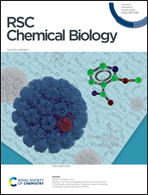Hydrophobic cavity-directed azide-acetyllysine photochemistry for profiling non-histone interacting partners of bromodomain protein 1†
Abstract
Bromodomain containing protein 1 (BRD1) plays critical roles in chromatin acetylation, gene transcription, erythropoiesis, and brain development. BRD1 is also implicated in several human conditions and is a therapeutic target for cancer. Although, the bromodomain is known to bind acetylated histones, how the function of BRD1 is regulated via non-histone acetylation is unexplored. To identify the non-histone acetylome of BRD1, we develop an R585AzF variant carrying photo responsive 4-azido phenylalanine (AzF) via amber suppressor mutagenesis. We demonstrate biochemical integrity of the AzF-containing analogue and its ability to crosslink non-histone interacting partners present in human cells. Subsequent proteomic experiments led to the identification of the novel BRD1 interactome representing diverse signaling pathways. As a proof-of-concept demonstration, we validated acetylated PDIA1 protein as a bona fide binding partner of BRD1. Our work suggests that BRD1 interacts with additional acetyllysine motifs, beyond those characterized in histone proteins.



 Please wait while we load your content...
Please wait while we load your content...